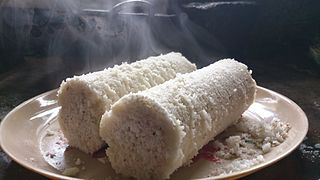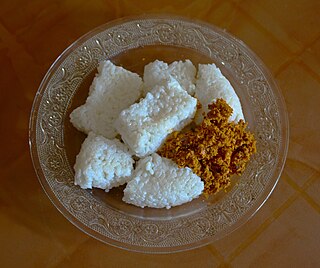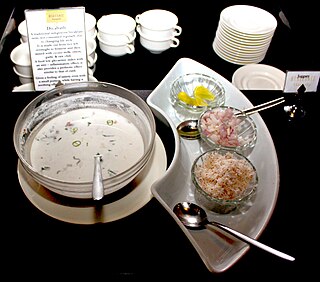Related Research Articles

Rice and curry is a popular dish in Sri Lanka, as well as in the Indian subcontinent.

Sri Lankan cuisine is known for its particular combinations of herbs, spices, fish, vegetables, rices, and fruits. The cuisine is highly centered around many varieties of rice, as well as coconut which is a ubiquitous plant throughout the country. Seafood also plays a significant role in the cuisine, be it fresh fish or preserved fish. As a country that was a hub in the historic oceanic silk road, contact with foreign traders brought new food items and cultural influences in addition to the local traditions of the country's ethnic groups, all of which have helped shape Sri Lankan cuisine. Influences from Indian, Indonesian and Dutch cuisines are most evident with Sri Lankan cuisine sharing close ties to other neighbouring South and Southeast Asian cuisines.

The culture of Sri Lanka mixes modern elements with traditional aspects and is known for its regional diversity. Sri Lankan culture has long been influenced by the heritage of Theravada Buddhism passed on from India, and the religion's legacy is particularly strong in Sri Lanka's southern and central regions. South Indian cultural influences are especially pronounced in the northernmost reaches of the country. The history of colonial occupation has also left a mark on Sri Lanka's identity, with Portuguese, Dutch, and British elements having intermingled with various traditional facets of Sri Lankan culture. Additionally, Indonesian culture has also influenced certain aspects of Sri Lankan culture. Culturally, Sri Lanka possesses strong links to both India and Southeast Asia.

Idiyappam, also known as string hopper, indiappa, noolputtu, noolappam, or ottu shavige, is a string hopper dish originating from the Indian state of Kerala and Tamilnadu. It consists of rice flour pressed into noodles, laid into a flat disc-like shape and steamed. The dish also spread to Southeast Asia, where it is called putu mayam in Malaysia and Singapore, and putu mayang in Indonesia.

Puttu in Sri Lanka, is a dish native to the Sri Lanka and South Indian states of Kerala, Tamil Nadu, and parts of Karnataka. Puttu means "portioned" in Tamil and Malayalam. It is made of steamed cylinders of ground rice layered with coconut shavings, sometimes with a sweet or savory filling on the inside. Puttu is usually a breakfast dish served hot with either sweet side dishes such as palm sugar or banana, or savoury with chana masala, chutney, rasam, or meat curries.

Appam or āppa in Sri Lanka is a type of thin pancake originating from South India and Sri Lanka. It is made with fermented rice batter and coconut milk, traditionally cooked in an appachatti, a deep pan similar in shape to a wok. It is part of Kerala and Tamil cuisine found in the Indian states of Tamil Nadu and Kerala and Sri Lanka. Appam are most frequently served for breakfast or dinner, often with a topping such as an egg.

Maldives fish is cured tuna traditionally produced in Maldives. It is a staple of the Maldivian cuisine, Sri Lankan cuisine, as well as the cuisine of the Southern Indian states and territories of Lakshadweep, Kerala and Tamil Nadu, and in the past it was one of the main exports from Maldives to Sri Lanka, where it is known as umbalakaḍa (උම්බලකඩ) in Sinhala and masikaruvadu in Tamil.It is also produced in small scale using traditional methods in Lakshadweep Islands in India. It is known as massmin in Lakshadweep.

Watalappam is a coconut custard pudding made of coconut milk or condensed milk, jaggery, cashew nuts, eggs, various spices, including cardamom, cloves, and nutmeg, and sometimes thick pandan juice or grated vanilla pods.

Kiribath is a traditional Sri Lankan dish made from rice. It is prepared by cooking rice with coconut milk, hence this name, and can be considered a form of rice cake or rice pudding. Kiribath is an essential dish in Sri Lankan cuisine. It is very commonly served for breakfast on the first day of each month and also has added significance of being eaten for any auspicious moment throughout one's lifetime which are marking times of transition. It is one of the more renowned traditional dishes in Sri Lanka.

Kokis is a deep-fried, crispy Sri Lankan food made from rice flour and coconut milk. Although considered as a traditional Sri Lankan dish, it is believed to have come from the Dutch. This is an important dish when celebrating Sinhala New Year and plays a major role in the festivities.

Nasi kuning, or sometimes called nasi kunyit, is an Indonesian fragrant rice dish cooked with coconut milk and turmeric, hence the name nasi kuning.

Diyabath is a cold soup, traditionally consumed by the indigenous people of Sri Lanka as a breakfast item. It is made from rice left overnight to ferment and then mixed with coconut milk, onion, garlic and raw chili. It is not consumed regularly due to changing lifestyle.

Coconut production contributes to the national economy of Sri Lanka. The scientific name of the coconut is Cocos nucifera. Sri Lanka there are three varieties, tall variety, dwarf variety and King coconut variety. According to figures published in December 2018 by the Food and Agriculture Organization of the United Nations, it is the world's fourth largest producer of coconuts, producing 2,623,000 tonnes in 2018.

Pol sambol, or thenkai sambal, is a traditional Sri Lankan dish made from coconut, mostly used as an accompaniment with rice, string hoppers, hoppers and curries. It is a coconut relish, consisting of freshly grated coconut, shallots, dried whole chilies, lime juice, salt and Maldive fish.
Aasmi is a traditional Sri Lankan deep-fried sweet snack, which is served on Aluth Avurudda/Puthandu, weddings and birthdays.

Bibikkan is a traditional Sri Lankan coconut cake. It is a dark moist cake made of shredded coconut, jaggery and semolina combined with a mixture of spices. Bibikkan is commonly prepared and consumed in celebration of festive and religious occasions, including Christmas, New Year's Eve, Sinhala and Tamil New Year.
Kiri hodi, which literally translates to milk curry, is a popular and traditional Sri Lankan fragrant coconut milk gravy. Made using a few basic ingredients, this dish is traditionally served hot alongside pol sambola or idiyappam. Vegetables and fish can be added to the sauce to make a more substantial curry dish.

Thala Guli also known as thala bola, gingelly or gingili balls or rolls, are traditional Sri Lankan sweetmeats, made with sesame seeds, salt and jaggery. Thala means sesame in Sinhala and guli or boli refers to whether they are made in the shape of a roll/cylinder or a ball/sphere. In northeast Sri Lanka, they are known as ellu urundai or ellurundai which in Tamil translates as sesame balls.
References
- ↑ Channa Dassanayaka Sri Lankan Flavours: A Journey Through the Island's Food and Culture Hardie Grant Publishing, May 1, 2011 - Cooking - 168 pages pages 144, 145